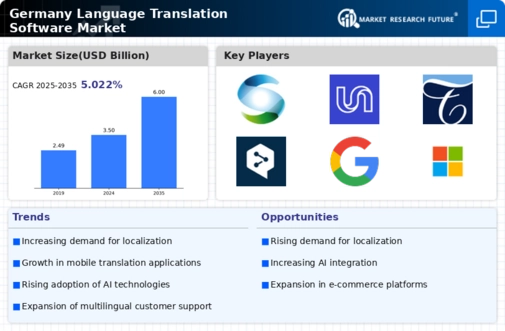Increased Focus on Customer Experience
The language translation software market in Germany is witnessing an increased focus on customer experience as businesses recognize the importance of personalized communication. Companies are investing in translation solutions that enable them to engage with customers in their preferred languages, thereby enhancing satisfaction and loyalty. In 2025, it is anticipated that the market will grow by 14%, driven by the need for businesses to provide tailored experiences. This trend is particularly relevant in sectors such as retail and hospitality, where customer interactions are critical. By leveraging translation software, organizations can ensure that marketing materials, product descriptions, and customer support are effectively localized. Consequently, the language translation-software market is likely to expand as businesses prioritize customer-centric strategies.
Expansion of E-Learning and Online Education
The expansion of e-learning and online education significantly impacts the language translation software market in Germany. With the increasing popularity of online courses and educational platforms, there is a growing need for translation tools that can cater to diverse student populations. In 2025, the market is projected to grow by 18%, driven by the demand for translated educational content. Educational institutions and training providers are seeking software that can efficiently translate course materials, ensuring accessibility for non-native speakers. This trend not only enhances the learning experience but also broadens the reach of educational programs. As a result, the language translation-software market is likely to thrive in response to the evolving landscape of education.
Rising Demand for Multilingual Communication
The language translation software market in Germany experiences a notable surge in demand for multilingual communication solutions. As businesses expand their operations internationally, the necessity for effective communication across diverse languages becomes paramount. This trend is particularly evident in sectors such as e-commerce and customer service, where companies seek to enhance user experience by providing localized content. In 2025, the market is projected to grow by approximately 15%, driven by the increasing need for businesses to cater to a multilingual customer base. Furthermore, the rise of remote work has amplified the requirement for translation tools that facilitate seamless communication among teams spread across different linguistic backgrounds. Consequently, the language translation-software market is likely to witness sustained growth as organizations prioritize effective communication strategies.
Growing Importance of Compliance and Regulation
The language translation software market in Germany is increasingly influenced by the growing importance of compliance and regulation. As businesses navigate complex legal frameworks, the need for accurate translations of legal documents and compliance materials becomes critical. In 2025, it is estimated that the market will see a 10% increase in demand for translation services related to regulatory compliance. This trend is particularly relevant in industries such as finance and healthcare, where precise translations are essential to meet legal requirements. Companies are investing in translation software that ensures adherence to local regulations, thereby mitigating risks associated with miscommunication. Consequently, the language translation-software market is likely to expand as organizations prioritize compliance-driven translation solutions.
Technological Advancements in Translation Tools
Technological advancements play a crucial role in shaping the language translation software market in Germany. Innovations such as machine learning and natural language processing have significantly improved the accuracy and efficiency of translation tools. In 2025, the market is expected to reach a valuation of €1.2 billion, reflecting a compound annual growth rate (CAGR) of 12% over the next five years. These advancements enable software to provide real-time translations, which are essential for businesses operating in fast-paced environments. Moreover, the integration of AI-driven features enhances user experience by offering context-aware translations. As technology continues to evolve, the language translation-software market is poised to benefit from increased adoption of sophisticated tools that cater to the dynamic needs of users.




















Leave a Comment